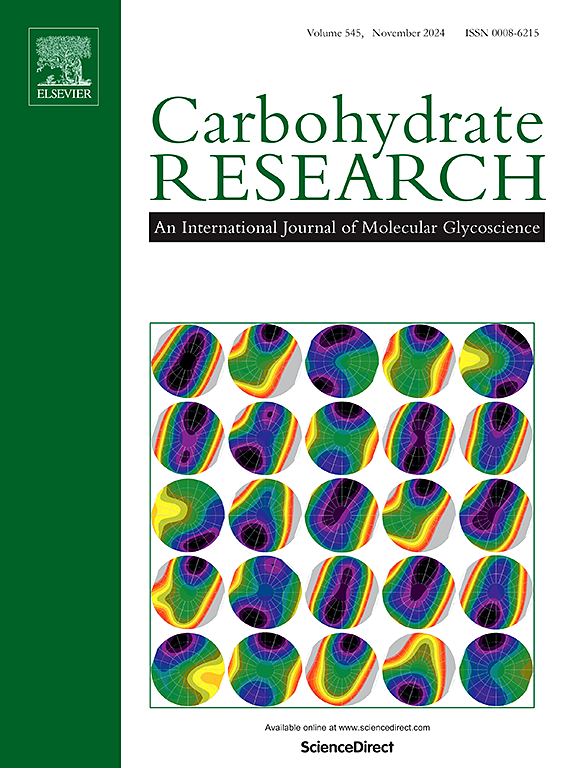The preparation of gel microspheres based on physical crosslinking by β-glucan isolated from Poria cocos residues and the powder characteristics
IF 2.5
3区 化学
Q3 BIOCHEMISTRY & MOLECULAR BIOLOGY
引用次数: 0
Abstract
Recently, polysaccharide based gel microspheres have become popular in biomedical fields due to their excellent biocompatibility and degradability. β-glucan, a kind of bioactive antitumor and immune polysaccharide, also shows great potentials in the microsphere preparation. However, most reported β-glucan based microspheres usually facing problems, including complicated components or procedures, and toxic chemical modification. In this work, we successfully obtained gel microspheres (PCPA-MS) only composed of β-glucans, with size between 8 and 26 μm, through hydrogen bonding by emulsion method. Moreover, β-glucan (PCPA) used in this work was extracted from the discarded medicinal residue with yield of 59 % after boiling Poria cocos. This is an important part of the recycling of traditional Chinese medicine to achieve green and sustainable development. In addition, the optimal construction conditions of PCPA-MS was concluded as 1 mol/L hydrochloric acid, 10 mg/mL PCPA, Span85: PCPA = 1:5 (m/v), rotational speed of 500 rpm, and isooctane: PCPA = 5:2 (m/v). Moreover, the prepared PCPA-MS displayed excellent powder characteristics, including good stability, strong water/oil absorption abilities, better adhesion rate and hiding power. Therefore, this work provide a simple, green and economical method to construct microspheres, which have promising application prospects in the fields of food, cosmetics, and even pharmaceuticals.

茯苓渣β-葡聚糖物理交联制备凝胶微球及其粉体特性
近年来,多糖基凝胶微球因其良好的生物相容性和可降解性而在生物医学领域得到广泛应用。β-葡聚糖是一种具有生物活性的抗肿瘤和免疫多糖,在微球制备中也显示出很大的潜力。然而,大多数报道的β-葡聚糖微球通常面临的问题,包括复杂的成分或程序,以及有毒的化学修饰。本研究成功地通过乳液法氢键合成了仅由β-葡聚糖组成的凝胶微球(pppa - ms),粒径在8 ~ 26 μm之间。此外,从茯苓废药渣中提取的β-葡聚糖(PCPA)产率为59%。这是中药回收利用实现绿色可持续发展的重要组成部分。结果表明,pppa - ms的最佳构建条件为:盐酸1 mol/L, PCPA = 10 mg/mL, Span85: PCPA = 1:5 (m/v),转速500 rpm,异辛烷:PCPA = 5:2 (m/v)。制备的PCPA-MS具有良好的粉体特性,稳定性好,吸水吸油能力强,附着力强,遮盖力强。因此,本工作为构建微球提供了一种简单、绿色、经济的方法,在食品、化妆品甚至制药等领域具有广阔的应用前景。
本文章由计算机程序翻译,如有差异,请以英文原文为准。
求助全文
约1分钟内获得全文
求助全文
来源期刊

Carbohydrate Research
化学-生化与分子生物学
CiteScore
5.00
自引率
3.20%
发文量
183
审稿时长
3.6 weeks
期刊介绍:
Carbohydrate Research publishes reports of original research in the following areas of carbohydrate science: action of enzymes, analytical chemistry, biochemistry (biosynthesis, degradation, structural and functional biochemistry, conformation, molecular recognition, enzyme mechanisms, carbohydrate-processing enzymes, including glycosidases and glycosyltransferases), chemical synthesis, isolation of natural products, physicochemical studies, reactions and their mechanisms, the study of structures and stereochemistry, and technological aspects.
Papers on polysaccharides should have a "molecular" component; that is a paper on new or modified polysaccharides should include structural information and characterization in addition to the usual studies of rheological properties and the like. A paper on a new, naturally occurring polysaccharide should include structural information, defining monosaccharide components and linkage sequence.
Papers devoted wholly or partly to X-ray crystallographic studies, or to computational aspects (molecular mechanics or molecular orbital calculations, simulations via molecular dynamics), will be considered if they meet certain criteria. For computational papers the requirements are that the methods used be specified in sufficient detail to permit replication of the results, and that the conclusions be shown to have relevance to experimental observations - the authors'' own data or data from the literature. Specific directions for the presentation of X-ray data are given below under Results and "discussion".
 求助内容:
求助内容: 应助结果提醒方式:
应助结果提醒方式:


